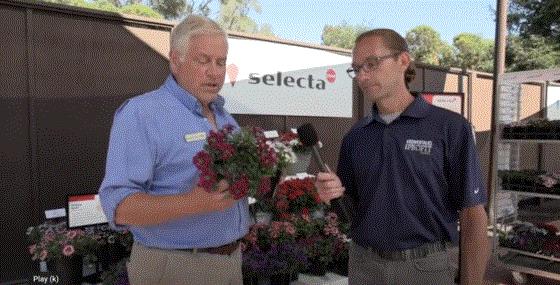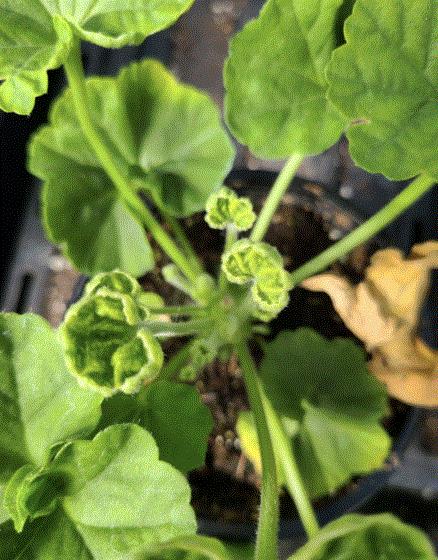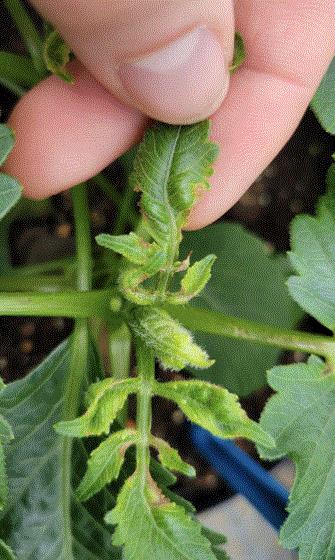CAST Throwback: Verbena Beats
I am writing this while riding in the back seat of a GMC Acadia, traveling with the Ball Publishing Bobbleheads as we cover the 2022 California Spring Trials. Chris Beytes, Jen Zurko, Osvaldo Cuevas (Ball Publishing's new video producer) and I just left the Santa Barbara Polo Grounds, where we met with a handful of plant breeders and introduction companies at one of our many CAST 2022 trial stops. Hopefully, you’ve been receiving our daily Acres of buZZ! newsletter and following us up the coast via new variety write ups and VIDEOS. (If not, click HERE to subscribe ... it automatically goes to all Acres Online and buZZ! subscribers.)

One of the new variety highlights from last year’s trials was Verbena Beats from Selecta One. While we were walking the Selecta trial this year, they reiterated a message and I wanted to pass it along since some of you may be growing Beats this year. This is a no-pinch verbena. If you pinch the liners, you’ll end up with a plant that branches and flowers around the edges but leaves a bare spot on the top.
Check out THIS VIDEO with Selecta’s Gary Vollmer, where he shares this tip and some others to help you produce a top-notch crop of Verbena Beats.

CAST Throwback: Coleus Spitfire
At our first CAST 2022 stop a couple days ago, I was happy to see a second micro-sized coleus added to the Ball FloraPlant assortment. New Matchsticks joins last year’s intro Spitfire to form a new “micro” coleus series called MicroBlaze. With these two, micro means just that, because these little guys are small. They make excellent combo components and specimens in small tabletop pots.

The trick with these is to not PGR them at any stage. PGRs will shut them down, as explained by BFP’s James Doukas in this VIDEO. If you’re finishing a crop of Spitfire this season, if you heed his advice you’ll end up with a very nice crop.
Nick’s Tip of the Week: Mystery Leaf Curl & Distortion
Each week, I’ll work with my buddy Nick Flax, a technical services expert at Ball, to share a concern that’s come up during one of his numerous calls with growers across North America. This week, he’s been working with growers to solve leaf curling and distortion issues on a variety of crops.
PROBLEM: Now that most North American greenhouses are in finished production mode, the variety of issues hitting my desk has broadened significantly. Over the past couple of weeks, I have gotten a startling number of reports of aggressive leaf curling and distortion of newly unfolding leaves. Geraniums and New Guinea impatiens are often at the top of the list of the crops showing these symptoms.
Different factors can cause leaf curl, but when severe curling and distortion starts to appear suddenly on crops in your greenhouse, herbicide injury is a likely culprit. While there is little that you can do once herbicide injury occurs, it’s critical to assess the extent of the damage quickly, identify where and how the contamination occurred, and take action to prevent further damage.

NICK’S TIP: If you suspect your crops have suffered herbicide damage, you should assess, identify and then start taking action. Here’s more on each of those steps.
Assess the Damage. How bad was the exposure and is it worth trying to finish the crop?
-
If leaf curl and/or distortion is minor (for example, only the margin is affected and not the entire leaf) and only present on about 50% or less of the plant, chances are it will recover. Depending on severity, delay in flowering and finishing may occur, but this is a better alternative to losing the crop entirely.
-
If injury symptoms are severe (for example, entire leaves are curled or distorted) and present on more the about 50% of the plant, the likelihood that the crop can be turned around is low. In this situation, start looking for alternative quick-crops that can be plugged into your spring program so you have something to put on the benches.
Identify the Source. While figuring out where herbicide contamination came from can sometimes be tricky, there are a few things you can do to identify the source.
Look for patterns. If damage is most severe closest to air inlets and symptom severity decreases the further downwind you go, injury was most likely caused by herbicide drift entering your greenhouse.
-
There’s little that you can do to prevent drift that results from someone else’s herbicide application. Closing vents and temporarily reducing air flow if you see a spray crew nearby is about the best you can do, but this isn’t always possible.
-
If the damage is due to weed management efforts on your grounds, make sure you exercise good application practices in the future. Avoid spraying too close to vents, spraying on windy or hot days, and always follow the label instructions to avoid accidental drift damaging your crops.
Here’s an idea: Run an in-house experiment. Unfortunately, certain herbicides can get into your water source. If there isn’t a strongly location-based pattern and plants are sporadically showing symptoms throughout your greenhouse, drift is less likely (or less conclusively) the cause and you should test your water. Herbicide residue testing is often expensive, but a quick in-house exclusion test can help determine whether lab testing should be the next step. Here’s how you can do it:
-
Take several plants not showing symptoms, flag them, and set them aside.
-
For a couple of weeks, only irrigate these few plants with an external water source. Get a few jugs of drinking water from the grocery store or home and mix up small batches of water-soluble fertilizer, etc.
-
If symptoms continue to appear on your main crops and not on the ones you isolated and watered with an external source, lab testing should be your next step.
Take Action. If damage on your crops is due to herbicide drift from an application not made by you or your staff, the best course of action is to take a deep breath, cool down, and engage in productive dialogue with your neighbors.
Excluding disgruntled former employees, herbicide applicators do not want to cause damage to your crops. However, they won’t know it happened or understand the risks to you and your livelihood unless you engage with them. Establish procedures and communication lines with your neighbors to avoid future instances of herbicide injury.
If you suspect herbicides have infiltrated your water source, have a commercial lab test for residues. Depending on the herbicide and concentration of active ingredient in your water, impact on your crops may be transient or, worst-case scenario, long-term. In either case, secure a temporary source of clean water to irrigate your crops with. While this may be expensive and is certainly not ideal, it is better than losing an entire season’s worth of crops.
If lab results show you are dealing with a potent and persistent herbicide, installing an activated carbon filtration system will likely be necessary. Even if herbicide concentrations in your water are low and crops are fine for a time after transplant, injury symptoms will start to occur at some point once plants take up enough active ingredient. Growers who wait to act in situations like this often incur significant losses and sometimes go out of business due to repeated crop failures. Act quickly, make informed decisions and don’t sacrifice the long-term for the short-term, even if there’s an upfront cost to remediate the issue.

LED Efficiency & Lighting Quality
In a recent e-GRO blog, Michigan State University’s Heidi Lindberg wrote about LED lamp efficacy and explained all LEDs are not created equal and light quality varies quite widely. In the blog, she referenced a resource you’ll want to consult when and if you’re considering LEDs. The Design Lighting Consortium has compiled data from multiple types of horticultural fixtures into this STRAIGHTFORWARD REFERENCE. Can you believe that as of the time I’m writing this, there are more than 650 DLC-compliant lamps? No wonder there are so many questions about lighting coming up in just about every discussion I have with growers.

Explains Heidi, “If you are looking at purchasing LED lamps (either for low-intensity photoperiodic lighting or for high-intensity supplemental lighting), check the lamp efficacy of the product you are considering on the Design Lighting Consortium website. It will help you compare the efficacy of competing products and might help you make your decision.”

More on Lighting: Light Trespassing
Perhaps you’ve heard the term, but hopefully you haven’t had to deal with the ramifications of “light trespassing.”
Light tresspassing is an actual thing—it's sort of one step beyond light pollution. Basically, the installation of LEDs (and other greenhouse supplemental lighting) is coming under fire in some communities because light coming out of greenhouses is blamed for disrupting circadian rhythms and impacting sleep cycles of humans and animals in the vicinity. Health issues linked to disrupted sleep cycles range from depression to diabetes, and activists and lobbyists are on the lookout for violators.

Thomas Ford, an educator with Penn State Extension, covers this potential issue in great detail in a recent e-GRO blog titled LIGHT TRESPASS AN EMERGING ISSUE IN SOME GREENHOUSE PRODUCTION AREAS. Before you dismiss this new development as crazy, read the blog and educate yourself and your management team so you’re not caught off guard if someone comes knocking at your door with a cease and desist order. There are steps you can take, such as blackout curtains, to mitigate the light escaping your greenhouse at night. This is an issue to keep in the back of your mind because these days, challenges like this seem to come up more often.

Quick Tech Tip: Dahlia Nutrition
Have you seen marginal and interveinal necrosis on new growth and immature leaves of your dahlia crop? Take a look at this photo that our Tech On Demand experts recently received from a grower. If you see this type of symptom, here’s how to handle the challenge.

This is most likely calcium deficiency. It’s time to apply a foliar feed with calcium nitrate or calcium chloride. To improve uptake, include CapSil or another surfactant. Once you’ve gotten the symptoms under control, continue feeding with a Ca-based fertilizer.
For even more information, check out this VIDEO from Dr. Brian Whipker of North Carolina State University.
Finish Line …
After spending the past week in California visiting more than a dozen plant breeding companies, I’m reminded of something an industry veteran once told me when I was just getting started in the industry in the early 2000s. He asked me if I’d want to work for a company that still ran the business using a 286 computer (remember when computers were rated by their Intel chip designation?). Of course, the answer was a resounding “No way!” He went on to explain that filling a greenhouse with outdated genetics was fundamentally the same thing. Breeders develop our industry’s new technology with the goal of upgrading products and solving problems.
I always think of that conversation whenever I’m at trials. The folks in our industry working daily to create the latest innovations deserve a standing ovation. They spend most of their careers behind the scenes, but at California Spring Trials they truly shine. Seeing products they’ve been focused on for years proudly displayed with “NEW!” tags must be akin to seeing your kids walk across the stage at graduation.
If you interact with plant breeders, take the opportunity to congratulate them, thank them and give the all the support they deserve. Shout out to all the plant breeders who read my newsletter—your efforts are greatly appreciated!



Please feel free to send your comments, constructive criticism and topic ideas to me at bcalkins@ballhort.com.

Bill Calkins
Editor - Tech On Demand
This email was received by you and 25,711 other fine subscribers!
If you're interested in advertising in Tech On Demand, contact Kim Brown ASAP and she'll hook you up.